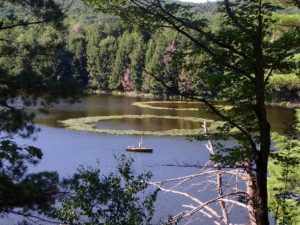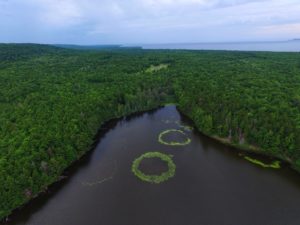Orderly patterns call for explanation — that might be one way of stating a general motivation for most of science. Several years ago, Prof. Don Waller — an ecological researcher from University of Wisconsin — was struck by the appearance of aquatic ‘fairy rings’ on Howe Lake. Viewed from the slopes of Huron Mt., the doughnut-like rings were obvious as floating bands of green, were quite regular in shape, and appeared to be several 10s of meters across with large, open centers. A simple round patch of vegetation might result from symmetrical outward growth of a patch of some aquatic plant, but the large patch of open water in the center of these rings was perplexing. Why would the plants in the center disappear?

from the shore of Howe Lake (photo courtesy of Susan Knight)
Waller showed a photo of the rings to Dr. Susan Knight, an aquatic-plant scientist at the Trout Lake Field Station of the University of Wisconsin’s Center for Limnology. Knight identified the ring-making plants as water-shield or pond-lily (Brasenia schreberi). Like typical water-lilies (to which it generally related, belonging to a ‘sibling family’), water-shield has floating leaves attached by a long petiole to creeping rhizome growing in sediment at the lake-bottom. The rings are apparently related to something influencing the growth patterns of the Brasenia rhizomes.
Knight was intrigued by the rings as an unusual, possibly unique phenomenon. Other plants and some fungi are known to form open rings when a clone grows outward in a relatively uniform habitat, and the central part of the clone subsequently dies out, forming the hole in the doughnut. Knight knew of one other lake, in northern Wisconsin, with ring-like growth patterns formed by aquatic plants, but those rings were smaller and formed by a completely different species.
Knight suggested several hypotheses for ring formation at Howe Lake. Initially, she suspected that small upwellings of cold groundwater might create sediment conditions unsuitable for Brasenia rhizome growth, accounting for the hollow ring centers. Another possibility was some pre-existing bathymetric (water-depth) pattern that could shape growth patterns. It has been suggested for terrestrial fairy-ring forming plants that an expanding clone might change soil chemistry in a way unfavorable to its own survival (either depleting nutrients, or depositing toxins), leading, again, to the plant dying out of the ring center.
In 2018 and 2019, Knight and colleagues from the Trout Lake Station visited Trout Lake to more fully document the ring’s properties and to test these hypotheses through detailed measurements of the physical and chemical properties of waters and sediments from Howe Lake. They also used historical aerial photographs to better understand the history of the rings. They determined that the rings were 50-60 m in diameter, and were expanding from year to year. However, they found no patterns in temperature or chemistry of soil or sediments that seemed to account for the ring shape; none of their initial hypotheses were supported.
All scientists are quite familiar with this ‘negative-results’ situation, which can sometimes be seen as (and feel like) a failed study. In fact, though, ‘null results’ are still valuable results! Excluding some possibilities is an important part of moving scientific understanding forward, and can stimulate more creative thinking. For now, though the Howe Lake rings — and why they are, perhaps, unique to Howe Lake — remain a mystery. Knight notes that the surface sediments of Howe Lake are extremely ‘flocculent’ (loose and unconsolidated), and speculates that the phenomenon may have some relationship to this fact.

The left-most ring has faded to near-invisibility.
A new ring may be forming to the right.
(photo courtesy of Susan Knight)
Meanwhile, even though the three rings observed in initial photos had persisted for several years (based on aerial photos from Google Earth), one of them had faded substantially in 2019. At the same time an ‘arc’ of Brasenia, perhaps a new ring beginning to form, is visible on the north side of the lake. Will the faded ring disappear completely or can rings re-establish? Are the rings a dynamic phenomenon, coming and going over the decades? Will similar rings be discovered in other lakes?
